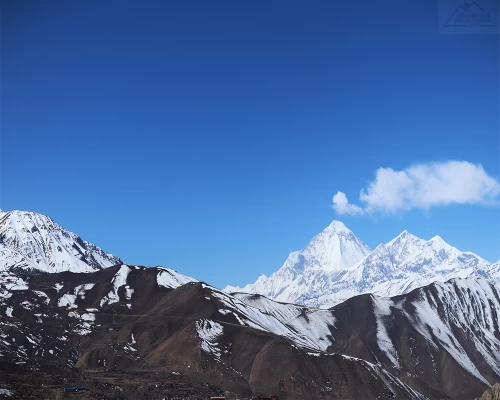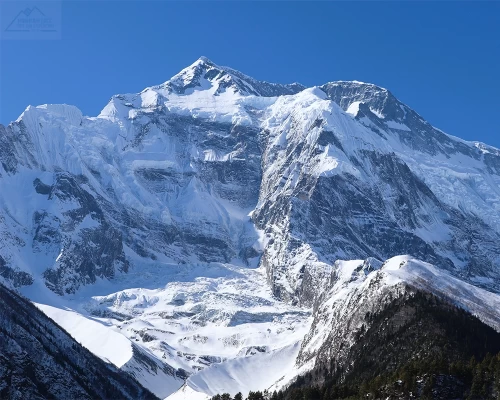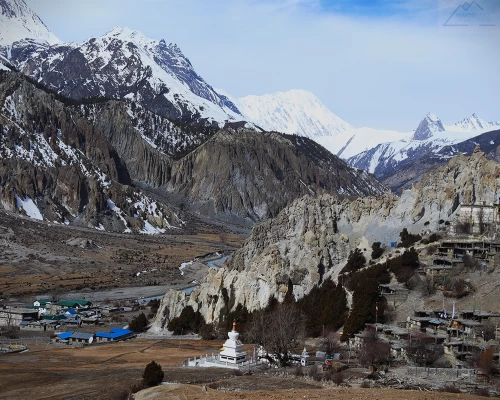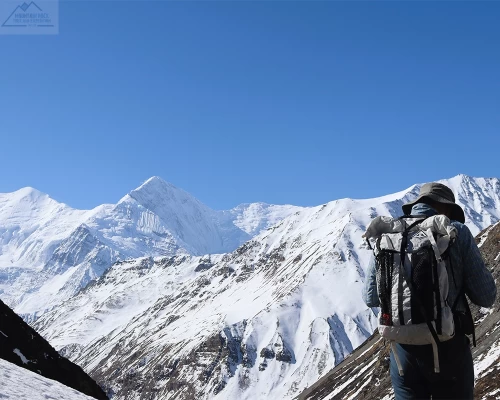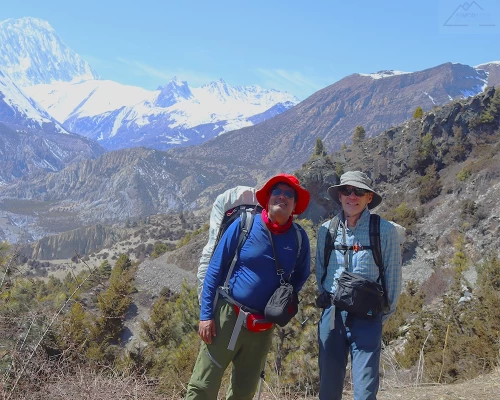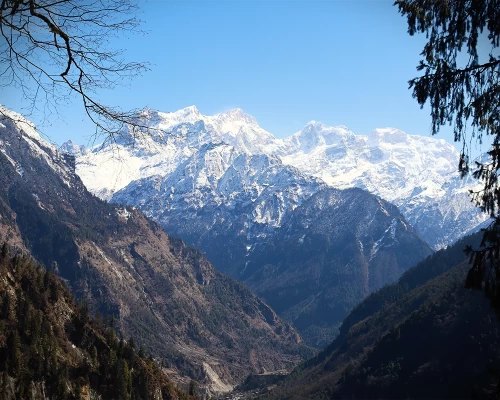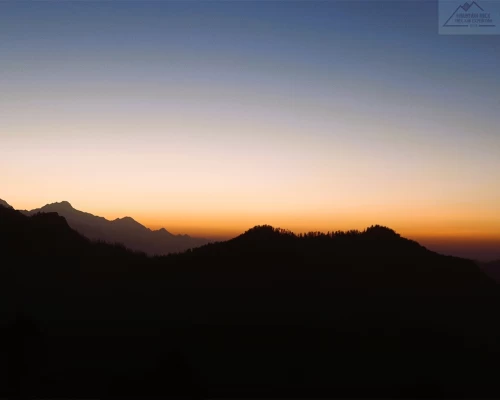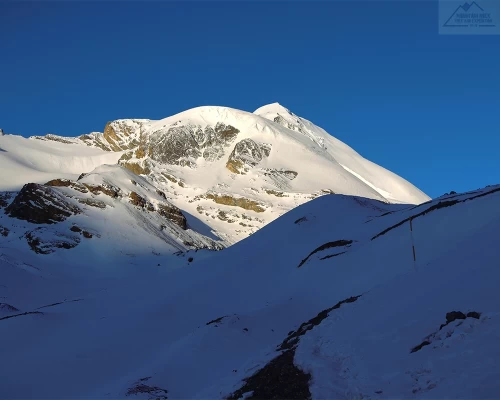Annapurna Circuit Guided Trekking In Nepal takes us to the world's most comprehensive pass. This trek starts from Besisahar and follows the Marsyangdi River with great views of Manaslu and Him Chuli to the east. This magnificent route leads you through traditional Manangi villages inhabited by friendly, habitual people who always offer a warm welcome amidst the magical, snow-capped Himalayas.
The first part of the Annapurna Circuit Trekking Itinerary is that of the Annapurna circuit route. However, from Manang, we ascend to Yak Kharkha, which has beautiful and innocent Himalayas views. After that, our trail continues to Phedi and Thorong La Pass, one of the widest passes in the world. We also climb up to Poon Hill, famous for its spectacular views of the Annapurna and Dhaulagiri ranges. On our Trekking in Annapurna Circuit Journey, we pass through forests, cross pristine meadows, and experience the change in vegetation while in the company of the glorious Himalayas.
Then, the ascent to the Thorong La Pass (5416m), the highest point in the trek, bestows us with spectacular views of Mustang Peak and the snow-covered giant - Dhaulagiri (8167m). We then reach the village of Muktinath, where we can see the sacred Hindu pilgrimage - Muktinath Temple with 108 spring water taps and mysterious natural gas fires on the Annapurna Circuit Trek 19 Day package. The descent from here follows the breathtaking Kali Gandaki River Valley.
A two-day descent from Muktinath, Tatopani is famous for its natural hot springs - perfect for relaxation and believed to heal diseases. The trek passes through Ghorepani, Tadapani, and Ghandruk and finally drives to Pokhara and Kathmandu.
Hiking the Annapurna Circuit will keep you focused and your camera clicking until your batteries run out because of the presence of a lot of mountains here. For instance, the famous Mt. Machapuchare, which looks like a Fish-tail (6,993 meters), the highest mountain in the world Manaslu and Dhaulagiri (8,167 meters and 8,163 meters) will certainly not let you get bored.
The route passes through varied villages where culturally rich ethnic communities like the Gurungs, Magars, Thakalis, and Tamangs reside. The path will lead you to different Buddhist villages and Hindu pilgrimage sites, including reaching one of Nepal's most revered Pilgrimage sites, i.e., Muktinath Temple.
Annapurna Circuit Trek from Kathmandu offers a taste of nature as it travels through fields, river gorges, mountainous valleys, and small hamlets in the mountains, giving you a true enigma about a Himalayan trek. The distance you would walk on Annapurna Circuit is around 150km (100 miles).
To experience the best Himalayas adventure in the Annapurna region, check out our best-designed 19-day Annapurna Circuit Trekking Itinerary. This detailed Itinerary is provided along with a map of the trekking area you will visit. Whether you are a beginner or an experienced hiker, this specially curated Itinerary and Map of the 19-day trip in the Annapurna circuit will surely help you by providing in-depth details of the hike. Book this trek with Mountain Rock Treks in the autumn and spring months at the best cost for 2025 and 2026.
Annapurna Circuit Trekking 19 Day Highlights
- Reach the highest point of 5416 meters at Thorong La Pass which is an amazing journey as well as an extreme challenge.
- Stroll through the green forest of oak and rhododendrons, where you can take in the breathtaking scenery of the Himalayas.
- Exploring the Nepalese Mountain culture through some off-the-beaten-track villages on the routes can give a good idea about the lifestyle of the local people.
- Visit one of the sacred temples with 108 stone faucets revered by Hindu and Buddhist pilgrims.
- Discover one of Braga's largest and most important monasteries, where you can learn about the region's spirituality on the trekking in Annapurna Circuit journey.
- Enjoy the Annapurna Himalaya Ranges at their finest as you hike the Annapurna Circuit trek route.
- Enjoy the natural wonders like splendid lakes, glaciers, gorges, and waterfalls under the fascinating scenery.
- Immerse yourself in the customs of the Manang village's local population.
- Unwind yourself at the Tatopani Hot Spring (natural hot spring) and regain your health after many days of walking.
What Annapurna Circuit Trekking 19 Days Package Offers?
The Trek in Annapurna Circuit for a 19 day package offers a guided experience with deep exposure to Nepal's astonishingly beautiful Annapurna region. In addition to the wondrous scenery that it gently showcases, the package offers all essential services, including sleep, food, and well-informed guides and porters. This Annapurna Circuit Trekking Package 19-day package offers travelers a comprehensive adventure characterized by cultural encounters, varied landscapes, and the joy of subduing high-altitude mountains. Here is more what the Package offers below:
- The package offers an opportunity to transverse the beautiful and peaceful route with the extensive alpine woods or towering Himalayan peaks.
- Opportunity to cross Thorong La Pass, one of the highest passes in the Annapurna region.
- Experienced and certified trekking guides ensuring safety and knowledge of the route.
- Quality accommodation in tea houses throughout the journey.
- Well-managed and secure Trek to Annapurna Circuit for 19 days in the Annapurna area.
- Thoughtfully planned trek itinerary, including a day for acclimatization at Manang.
- Support for any necessary permits and logistics.
- Memorable experiences and camaraderie with fellow trekkers amidst the breathtaking scenery.
- The hike offers an opportunity to conquer one of the world's highest mountain passes at an elevation of 5,416 meters, Thorong la pass, and reach one of the sacred temples Muktinath Temple in a single journey.
- The package offers Optional side trips to Tilicho Lake.
Join Annapurna Circuit Trekking 19 Days Solo, Private or In Group From Pokhara or Kathmandu
At Mountain Rock Treks, we know that each of our explorers is keen to experience a different adventure. Here, we offer options ranging from Annapurna Circuit Joining Treks designed for a particular trip and budget to improve your travel. This means you now choose to go on the Annapurna trek solo in a private or in a group.
Whether you choose a solo, private, or group Annapurna Circuit Trekking Package, you are accompanied by the qualified and experienced team members of Mountain Rock Treks. The guides who will trek with us are not only hikers experts but also the ones who know the Annapurna region like the back of their hands. They will be your guides for the whole 19 days trip, and they will teach you the local culture, flora, and fauna so that you learn much more during the trip than just the beautiful scenery.
Join the Annapurna Circuit trek along the Annapurna range from Pokhara to Kathmandu. We from Mountain Rock Treks propose a Customised itinerary that will suit your requirements and interests. We want you to have the best experience of the Himalayas. Feel free to contact us for the Itinerary Customization.
Is Annapurna Circuit Trekking 19 Days Right for You?
- A trek to the Circuit Trail of Annapurna is quite strenuous and calls for moderately good physical condition. It's not necessarily technically challenging, but hikers have to do a lot of walking for 5 to 6 hours a day, gradually increasing altitude. If you are ready for this challenge, this trip is right for you.
- If you are an enthusiast of travel hikes and have sufficiently gained experience in carrying your light backpack, then you can join this trek.
- It is an adventure rather than a hike. If you can embrace the long days and sometimes changeable weather then the trip is the one for you.
- If you crave an awe-inspiring Himalayan view, the Annapurna Circuit Excursion will satisfy your desire to the maximum. See snow-topped mountains, different landscapes, and deep canyons.
- The hike gives you a peep into the daily life of the locals. Talk with friendly guides and teahouse owners, visit stunning old monasteries, and ogle Buddhist stupas and mani stones placed along the trail. If you want this kind of experience, this is the adventure you don't want to miss.
- It is not a must, but a trekking experience in a rocky environment can be quite helpful. This will prepare you mentally for what to expect on the trail and assist you in acclimatizing to the altitude on a higher level.
If these points resonate with you, the Annapurna Circuit trek could be the adventure of a lifetime.
Annapurna Circuit Trekking 19 Days Cost 2025 and 2026
Annapurna Circuit Trekking 19 Day cost ranges from $958 to $1063 per person, depending on the number of people in the group. We provide solo, private, and group trips starting from Pokhara or Kathmandu at Mountain Rock Treks.
The trek cost package includes accommodation, daily meals, an English-speaking trip guide, permits, the best itinerary, etc. This package does not include the cost of drinking water or showers, which you have to pay for additionally, nor does the tip for guides and porters or the personal travel insurance, which is a separate charge.
Here are the Annapurna Circuit Trekking Package cost we offer for different no of people below:
No Of Pax | Cost Per Person | Status |
2-6 | $ 1063 | |
7-12 | 1009 | |
13-30 | $958 |

